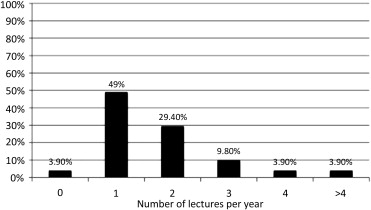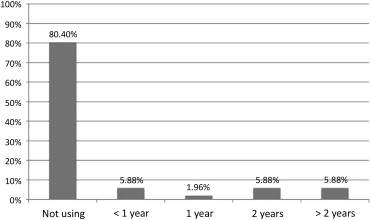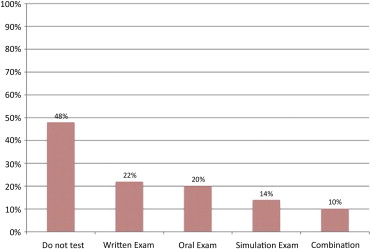Rationale and Objectives
Acute allergic-like adverse reactions to contrast media are rare but life-threatening events. Residents may complete training without ever managing such an event. Surveys have shown practicing radiologists to incorrectly dose and administer medications for treatment. Thus, contrast education may be deficient or inconsistent. The purpose of this study was to assess the current status of contrast reaction education in US radiology residency programs and the methods used to test residents’ knowledge.
Materials and Methods
A 10-question anonymous survey on residency education methods and testing pertaining to allergic-like adverse events to contrast media was distributed through the Association of Program Directors in Radiology to program directors of US diagnostic radiology residency programs. The past 4 years of the American College of Radiology in-service examination were reviewed to assess the number of contrast reaction questions.
Results
Fifty-one programs responded to the Association of Program Directors in Radiology survey. Forty-nine percent of programs train with one lecture per year, 29.4% train with two lectures, and 16% train with three or more lectures. Only 44% include role-playing training during the lectures. Eighteen percent of programs are incorporating simulation training. Fewer than 50% of programs formally test residents’ knowledge, and there were no questions on the 2007 to 2010 American College of Radiology in-service examinations.
Conclusions
Resident education for contrast reaction management is primarily performed with annual lectures. Only 18% of programs are using simulation training, and <50% are testing residents’ knowledge or skills. These findings suggest that education may need revision to incorporate simulation or other means of psychomotor learning.
Methods of educating radiology residents have evolved over the past decade. There has been an increase in the implementation of small-group sessions, simulation training, and Web-based models . This educational trend has occurred in part because of required compliance with the Accreditation Council for Graduate Medical Education’s six domains of clinical competence: patient care, medical knowledge, practice-based learning and improvement, interpersonal and communication skills, professionalism, and systems-based practice . The Accreditation Council for Graduate Medical Education recommends the use of the educational method of high-fidelity simulation as one way of incorporating these domains .
Intuitively, simulation training and other types of psychomotor learning would be more applicable than lectures for learning procedural radiology skills and handling medication administration, such as when managing allergic-like reactions to iodinated contrast media and gadolinium-based contrast agents. Hands-on training may be the only opportunity to apply didactic material, because of the rarity of allergic-like reactions to iodinated contrast media, estimated at a incidence of only 0.05% to 3.1% . Moderate or severe reactions are even less common, accounting for only 0.04% to 0.08% of all adverse events . Thus, a resident may complete a 4-year residency program without ever encountering an allergic-like adverse event to iodinated or gadolinium-based contrast media. This may explain the alarming results of several recent surveys.
Get Radiology Tree app to read full this article<
Get Radiology Tree app to read full this article<
Materials and methods
Get Radiology Tree app to read full this article<
Table 1
Survey Questions Sent Through the Association of Program Directors in Radiology
1. Each year, how many lectures do your residents receive on contrast reactions? 2. Do the lectures ever include practice scenarios/role playing? 3. Do the lectures ever include hands on learning of what the different drugs look like and how to administer them? 4. Do the residents receive special contrast reaction training during their CPR, Basic Life Support, and/or Advanced Life Support courses? 5. Do your residents get Simulation Training (with interactive mannequins) to learn about contrast reactions? 6. If yes, how long has your residency been using simulation? 7. If yes, how many simulation sessions do you hold per year? 8. How do you test residents on their knowledge of contrast reactions? Please mark all that apply. 9. Do you use computer-based programs to teach residents about contrast reactions? 10. If yes, how long has your residency been using computer programs?
CPR, cardiopulmonary resuscitation.
Get Radiology Tree app to read full this article<
Get Radiology Tree app to read full this article<
Results
Get Radiology Tree app to read full this article<
Get Radiology Tree app to read full this article<
Get Radiology Tree app to read full this article<
Get Radiology Tree app to read full this article<
Discussion
Get Radiology Tree app to read full this article<
Get Radiology Tree app to read full this article<
Get Radiology Tree app to read full this article<
Get Radiology Tree app to read full this article<
References
1. Towbin A.J., Paterson B.E., Chang P.J.: A computer-based radiology simulator as a learning tool to help prepare first-year residents for being on call. Acad Radiol 2007; 14: pp. 1271-1283.
2. Accreditation Council for Graduate Medical Education. Common program requirements: general competencies. Available at: http://www.acgme.org/outcome/comp/GeneralCompetenciesStandards21307.pdf . Accessed April 16, 2011.
3. Accreditation Council for Graduate Medical Education: Toolbox of assessment methods.1999.Accreditation Council for Graduate Medical EducationChicago
4. Cochran S.T., Bomyea K., Sayre J.W.: Trends in adverse events after IV administration of contrast media. AJR Am J Roentgenol 2001; 176: pp. 1385-1388.
5. Palmer F.J.: The RACR survey of intravenous contrast media reactions: final report. Australas Radiol 1988; 32: pp. 426-428.
6. Velasco Martin A., Perez Gonzalez E., Cortejoso Hernandez F.: Monitoring of adverse reactions to iodinated contrast media in in-patients and out-patients. Farm Clin 1996; 13: pp. 596-609.
7. Wang C.W., Cohan R.H., Ellis J.H., et. al.: Frequency, outcome, and appropriateness of treatment of nonionic iodinated contrast media reactions. AJR Am J Roentgenol 2008; 191: pp. 409-415.
8. Katayama H., Yamaguchi K., Kozuka T., et. al.: Adverse reactions to ionic and nonionic contrast media: a report from the Japanese Committee on the Safety of Contrast Media. Radiology 1990; 175: pp. 621-628.
9. Lightfoot C.B., Abraham R.J., Mammen T., et. al.: Survey of radiologists’ knowledge regarding the management of severe contrast material induced allergic reactions. Radiology 2009; 25: pp. 691-696.
10. Bartlett M.J., Bynevelt M.: Acute contrast reaction management by radiologists: a local audit study. Australas Radiol 2003; 47: pp. 363-367.
11. Krupinski E.A., Patel B., Berger W., et. al.: Assessing radiology resident preparedness to manage IV contrast media reactions using simulation technology. Stud Health Technol Inform 2009; 142: pp. 139-141.
12. Gaca A.M., Frush D., Hohenhaus S., et. al.: Enhancing pediatric safety: using simulation to assess radiology resident preparedness for anaphylaxis from intravenous contrast media. Radiology 2007; 245: pp. 236-244.
13. Tofil N.M., Lee White M., Grant M., et. al.: Severe contrast reaction emergencies high-fidelity simulation training for radiology residents and technologists in a children’s hospital. Acad Radiol 2010; 17: pp. 934-940.
14. Tubbs R.J., Murphy B., Mainiero M.B., et. al.: High-fidelity medical simulation as an assessment tool for radiology residents’ acute contrast reaction management skills. J Am Coll Radiol 2009; 6: pp. 582-587.
15. Wang C., Schopp J., Petscavage J., et. al.: Prospective randomized comparison of standard didactic lecture versus high fidelity simulation for radiology resident contrast reaction management training. AJR Am J Roentgenol 2011; 196: pp. 1288-1295.
16. Petscavage J.M., Wang C.L., Schopp J.G., et. al.: Cost analysis and feasibility of high-fidelity simulation based radiology contrast reaction curriculum. Acad Radiol 2011; 18: pp. 107-112.
17. Schwid H.A., Rooke A.G., Ross B.K., et. al.: Use of a computerized advanced cardiac life support simulator improves retention of advanced cardiac life support guidelines better than a textbook review. Crit Care Med 1999; 27: pp. 821-824.


